Ecology and Evolution Exam 2 Vocabulary
1/49
Earn XP
Description and Tags
BIOL 2100
Name | Mastery | Learn | Test | Matching | Spaced |
|---|
No study sessions yet.
50 Terms
Life history strategy
A schedule of lx and bx that maximized offspring production and survival in a particular environment (often maximized r)
Type I survivorship Curve
Good juvenile survivorship, poor adult survivorship (ex. humans)
Type II survivorship curve
Chances of survivorship remains the same throughout their lifespan (not as common)
Type III survivorship curve
Poor juvenile survivorship but good adult survivorship
semelparity
Reproduce one time (“boom and bust”) (ex. salmon)
iteroparity
reproduce multiple times within a lifespan (ex. humans)
How to increase r in a life table?
reduce age at first reproduction
increase litter size
increase in number of litters
increase survivorship of juvenile and reproductive age classes
Loles’ Law
r(iteroparous) ~ r(semelparous + 1 more offspring/individual)
bet-hedging strategy
A survival strategy that involves producing offspring with varying levels of resilience/risk in an uncertain environment. Ensures a degree of success even if some individual outcomes are unfavorable. (ex. diversified germination in plant seeds, some sprout in 1 year, some in 10, some in 50 in case of unfavorable conditions causing 1 group to die)
R-selection
R-selected species produce many offspring with minimal parental care to quickly exploit available resources.
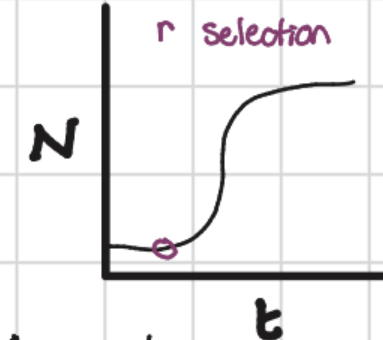
k-selection
K-selected species are born into a crowded, resource limited environment. Produce fewer offspring but invest heavily in each, ensuring a higher probability of survival to adulthood
Exploitation competition
Indirect, shared resourcesI
Interference competition
direct, behavior, territoriality. Affect exploitation efficiency of competitor. (ex. alleleopathy)
Pre-emptive competition
Competition for space as a resource (ex. plants, mairine invertebrates). Blend of exploitation and interference competition
Lotka-Volterra Competition equations (L-V)
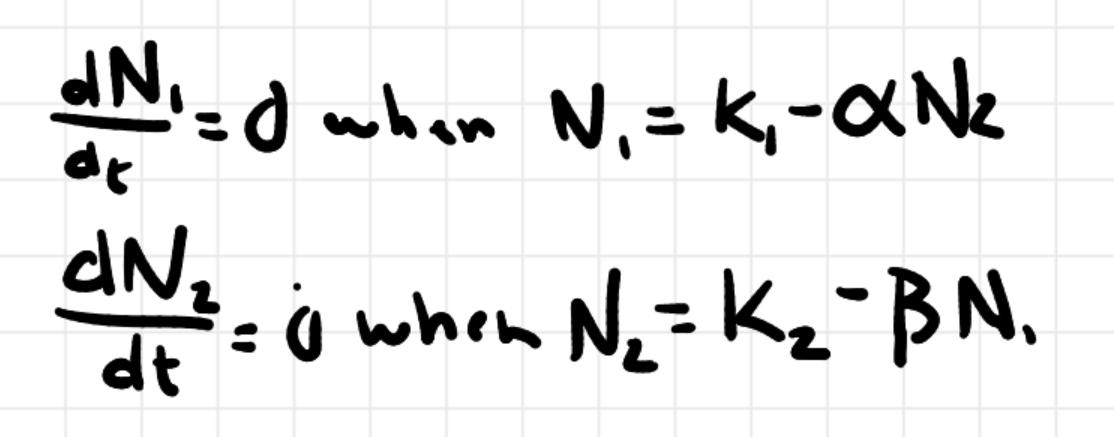
alpha
effect of N2 on population growth rate of N1, measured in units of N1. Measures interspecific vs intraspecific interactions
meaning of alpha = 1
interspecific competition = intraspecific competition
meaning of alpha > 1
N2 has a greater effect on N1 than N1 has on N1.
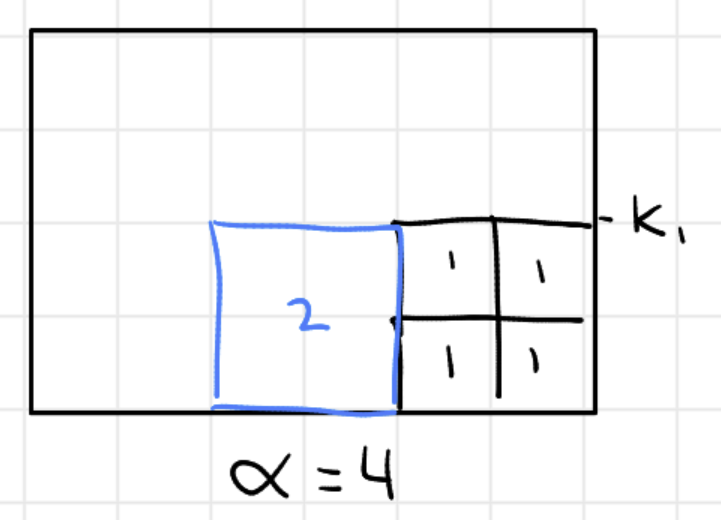
meaning of alpha = 0?
no interspecific effect
meaning of alpha < 0?
helping population growth, indicates symbiotic relationship or prey outcome
Meaning of alpha < 1
Intraspecific competition (N1) has a greater effect on N1 than interspecific competition (N2) does.
isocline
A combination of abundances of N1 and N2 such that dN1/dt = 0
Assumptions of L-V model
No Immigration of Emmigration
No age/size/genetic structure
No time lags
Constant K1, K2, alpha, beta
Case 1 L-V model
Species 1 wins
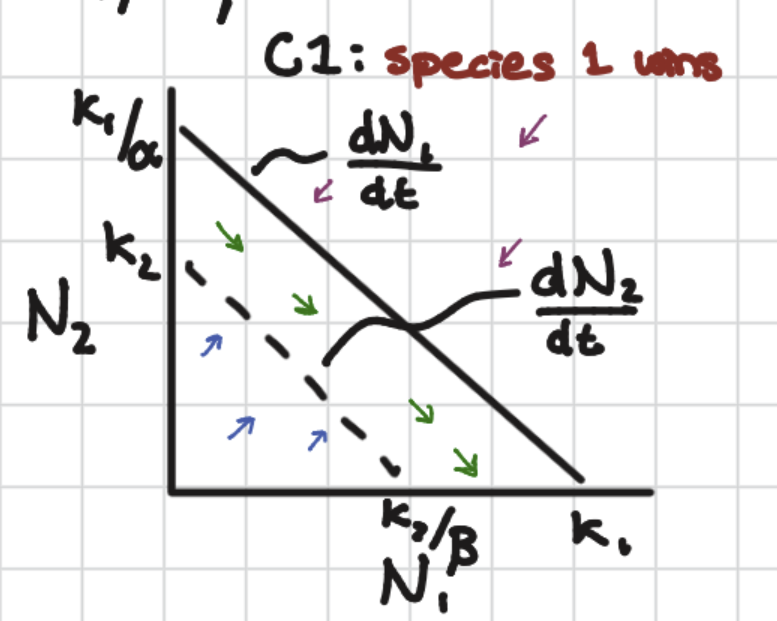
Case 2 L-V model
Species 2 wins
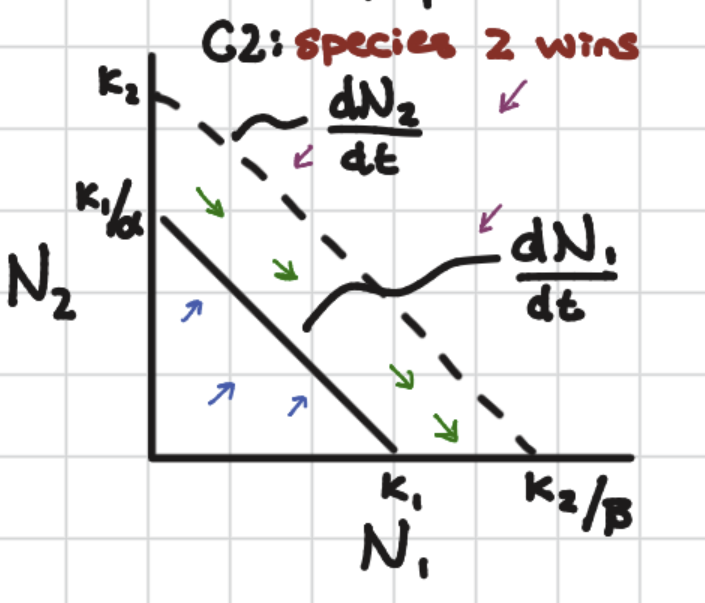
Case 3 L-V model
stable coexistence
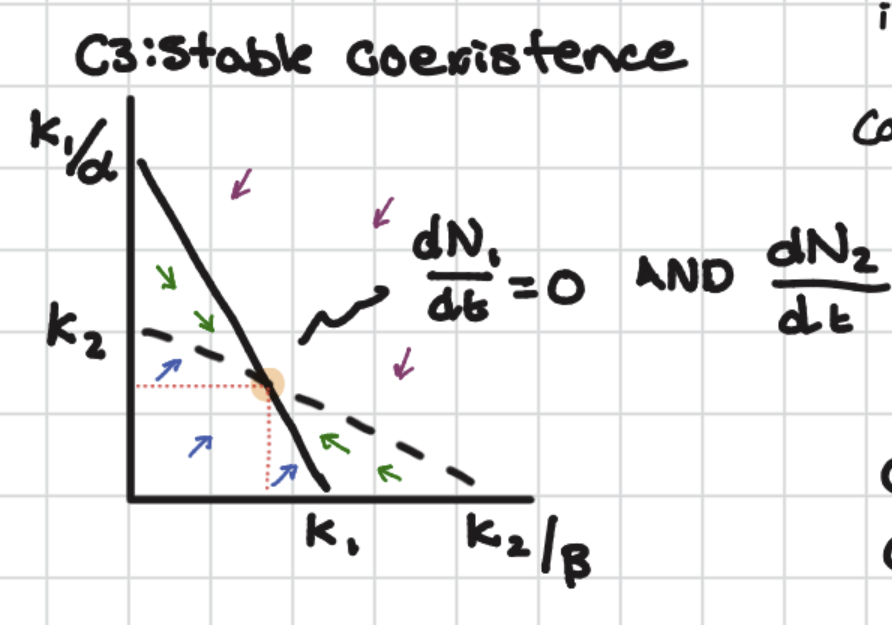
Case 4 L-V model
Unstable coexistence
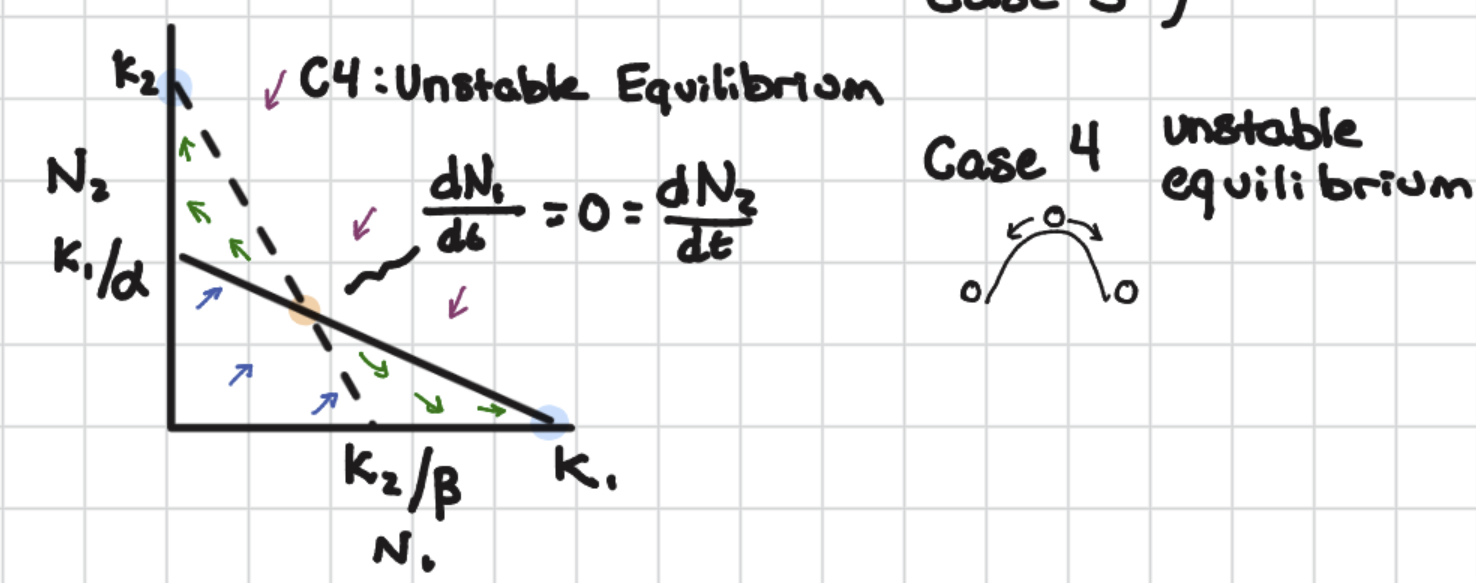
rationale for preserving species
moral/aesthetic arguments
Natural products
ecosystem services (climate, flooding erosion control, pollinator services)
Niche (Hutchinson definition)
An n-dimensional hypervolume that defines a set of conditions for which dN/dt > 0
Funamental niche
Species living alone in an environment
Realized niche
Species in presence of other species (took a bite out of cookie)
Charater displacement
Divergence in body size or morphology of competitors living in sympatry
In L-V model Case 3 superimposed with an empirical yield curve: would you over or under yield? Would you plant monoculture or polyculture?
Overyielding (dynamic equilibrium is above the yield curve), plant polyculture
In L-V model Case 3 superimposed with an empirical yield curve: would you over or under yield? Would you plant monoculture or polyculture?
Under yielding (dynamic equilibrium is under the yield curve), plant monoculture
Environmental niche space graph

Paradox of the plankton (Gause)
Refers to the observation that, contrasting the competitive exclusion principle that suggests only one species can dominate a single limiting resource, many species of plankton coexist in well-mixed aquatic environments.
rescue effect
Immigration to a local population prevents extinction
sink population
an ecological population living in a low-quality habitat that cannot sustain itself through local reproduction alone and relies on continuous immigration from a high-quality “source” habitat for its persistence (negative growth rate)
Source population
Has a positive growth rate and exports individuals to the sink population (negative growth rate)
Sympatry
Situation where different species/populations coexist and live in the same geographical area
Allopatry
State where 2 populations are in different geographic locations, preventing gene flow
Ecological assortment
Extinctions lead to the separation of species along niche areas
L-V predation model examples
Predation, parasitism, seed consumption, herbivory
Alpha (L-V Predator-Prey model)
Capture efficiency
How efficiently P kills V
Beta (L-V Predator-Prey model)
Conversion efficiency
Ability of P to convert V into offspring of P
dV/dt (equation, when is it equal to 0?)
rV - (alpha)VP
when p(hat) = r/alpha
dP/dt (equation, when is it equal to 0?)
(beta)VP - qP
when v(hat) = q/beta
Period of a cycle =
2pi/ sqrt(rq)
Assumptions of L-V Predator-Prey model
No I or E, No age, size, genetic structure, no time lags
No carrying capacity for V
P is a specialist on V
P and V encounter one another randomly in a homogenous environment
Individual predators are insatiable